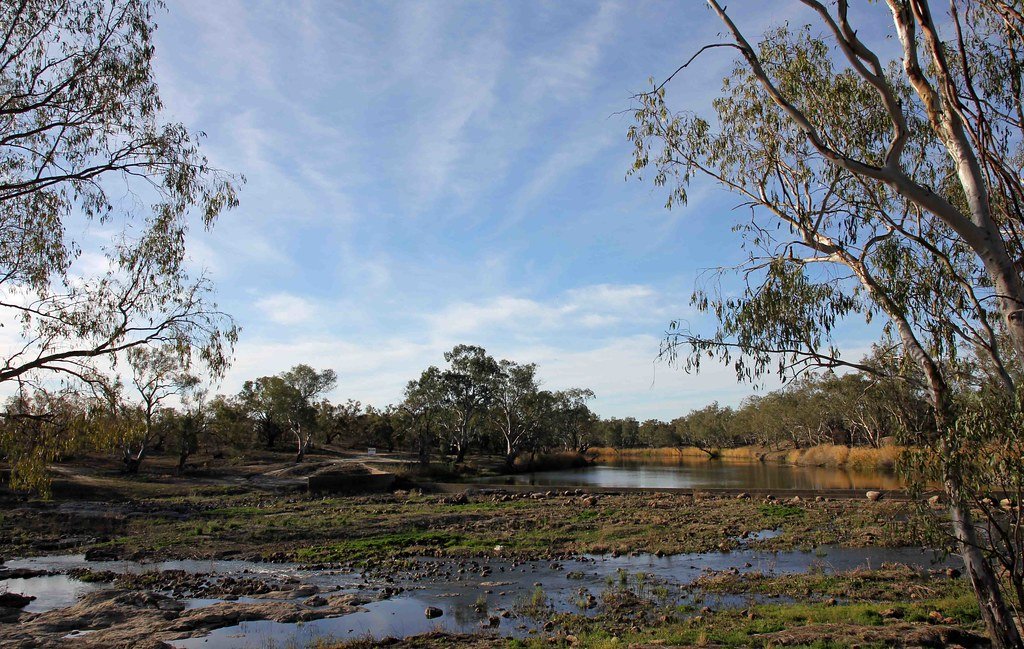Baiame’s ngunnhu - river fish traps
By Allison Stocks
Ancestral Connections & Geographic Extent Temporal Extent Biophysical Manipulations Target Species Ceremony & Stewardship Current Status
Brewarrina Fish Traps - Photo by iansand - licensed under CC BY-NC-ND 2.0
Ancestral Connections & Geographic Extent
Ngunnhu were created and stewarded by the Ngemba Wayilwan, aboriginal people from modern day southeastern Australia. The creation of the Ngunnhu is enshrined in ancient tradition; they were designed by Baiame, a great ancestral being, and built by his two sons during a time of severe drought in which the Ngemba Wayilwan were facing famine (Rando 2007).
Ngunnhu are exclusive to the Barwon River in present-day New South Wales in southeast Australia. There is a total of 1.8 km of teardrop-shaped stone weirs across a 400m rock bar extending across the riverbed.
Brewarrina Fish Traps - Photo by iansand - licensed under CC BY-NC-ND 2.0
Temporal Extent
While the exact age of the traps is unknown, they are estimated to be around 3,000 years old (Hope and Vines 1994). Ngunnhu are no longer in use today.The last time the fish traps were fully utilized and regularly maintained is estimated to be during the 1850s or 1860s (Rando 2007).
Biophysical Manipulations
The Ngunnhu are a series of teardrop-shaped stone weirs that extend across a shallow rock bar in the Barwon River. The rocks were placed tightly together, stabilized with large stones on the tops of the walls and arched against the river current (Hope and Vines 1994). Large numbers of fish were herded into the traps during the spring migration. “The old people wouldn't have to spear the fish, they would just walk into the river and catch them under the gills and fill their bugguda, their dilly bags, up with them,” (Rando 2007).
Baiame's Ngunnhu - Photo by B. Hanna - licensed under CC BY 4.0
Target Species
Commonly caught species include Murray cod (Maccullochella peelii), callop (Macquaria ambigua), silver perch (Bidyanus bidyanus) and freshwater catfish (Tandanus tandanus), which were recovered from the traps either by hand, net or spear, and during times of flood they were dived for (Roughley 1951).
Murray cod (Maccullochella peelii) - Illustrated by Lilly Crosby
Ceremony & Stewardship
Baiame’s Ngunnhu were the site of large gatherings, with thousands of people from nearby coming to fish for subsistence, cultural and spiritual purposes. The region supported an estimated 3,000 people (citation and state approximately when).
Current Status
The Ngunnhu are no longer in use today and there are a number of social and political factors that have contributed to their disuse. During the mid-1800s, large gatherings of Aboriginal people came to be viewed with suspicion. A policy of detribalization was introduced, in which family groups were separated from each other at different pastoral stations. The effects of this policy and the ongoing violence on the use of the fish traps by Aboriginal people were catastrophic. Citation needed.
Ngunnhu were dismantled over time. First rocks were moved to create a bridge, then cleared to allow for the passage of boats and used for nearby roadworks. Further deterioration resulted from the development of an upstream weir that drastically changed the water flow and led to increased silt deposits. Today, only 5% of the original system survives in a substantially intact form. There have been two attempts to restore the fish traps, one in the the 1970s by local Indigenous people, funded by a grant from the Directorate of Aboriginal Welfare, and a second, recent private reconstruction effort.
In 1988, the Brewarrina Aboriginal Cultural Museum was built near the fish traps to “offer visitors and community members the chance to experience Aboriginal culture firsthand.” The area remains a spiritual meeting place for teaching cultural renewal, understanding and tolerance. Baiame’s Ngunnhu was listed on the New South Wales State Heritage Register in 2000 and on the Australian National Heritage List in 2006.
The Ngunnhu have been described as having “high potential” for restoration. They are, however, protected as a “relic” under the National Parks and Wildlife Act 1974. Legally the site cannot be altered without the consent of the Department of National Parks and Wildlife and the Australian Heritage Commission. This could create a barrier for the local Brewarrina Indigenous community, though a detailed assessment of restoration potential was conducted in the 1990s that could provide the foundation for such efforts.
Rock traps at the Brewarrina Aboriginal Fisheries Ngunnhu of the Ngemba - Photo by Tim Connors, licensed under CC BY-NC-SA 2.0
References
Dargin, P. 1976. Aboriginal fisheries of the Darling-Barwon rivers. Brewarrina Historical Society, Brewarrina, N.S.W.
Hope, J., G. Vines, G. Gibbons, N. Perkins, C. Ogleby, and P. Dargin. 1994. Brewarrina fish traps conservation management plan. Brewarrina Aboriginal Cultural Museum, New South Wales.
Mathews, R. H. 1903. The Aboriginal fisheries at Brewarrina. Royal Society of New South Wales, Sydney, New South Wales.
Murdi Paaki Regional Assembly. (n.d.). Brewarrina Fish Traps webpage https://www.mpra.com.au/brewarrina-fish-traps, accessed 2 February 2022.
Roughley, T. C. 1951. Fish and fisheries of Australia. Angus and Robertson, Sydney.
Winda Mara Aboriginal Corporation. 2008. Lake Condah Restoration Project conservation management plan. Report prepared by Context Pty Ltd for Winda Mara Aboriginal Corporation, Heywood.




